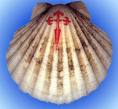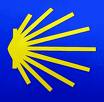After a great dinner in Palas del Rei and a nice comfortable stay overnight, we left the town on Day 4 to head to Boente, a tiny town and our next overnight. On this day, I would walk 21 km (about 13 miles) in around 5 hours to get to my destination. But we would first make a stop in Mélide to try its famous “pulpo” (octopus). Now, I am not a fan of octopus and similar ugly sea creatures but I had heard about how good the pulpo was in this part of Spain so we took off from Palas del Rei knowing lunch would be in the town of Mélide – I had to try it, I mean, I didn’t come this far to not try the local specialty!
But let’s not get ahead of ourselves, we had to have a mid-morning snack (even though the breakfast at the hotel in Palas del Rei was pretty darn good!).
After eating that monster (OK, I shared…), I had too much energy as my trek roommate, Emory, could attest…
As usual, the path is well marked and consists of a wide range of trail types, some more natural than others.




 It is always amazing how there is a symbiosis between the age-old trails and the farms or villages the trails go through. Sometimes you feel bad you are walking right by people’s homes but, it is likely that the trail was there first…
It is always amazing how there is a symbiosis between the age-old trails and the farms or villages the trails go through. Sometimes you feel bad you are walking right by people’s homes but, it is likely that the trail was there first…
One of my favorite parts of the walk is running into the old churches in the small towns along the way. I am not sure how active these churches are (I am sure they don’t all have their own priest) but they serve as witnesses to the needs of the pilgrims back when the Camino was truly a journey of faith, not just a modern-day trek.
One of the good things about the Camino is the availability of clean, safe water to drink so you don’t have to be buying bottled water or treating water. I filled my bottles at the places I stayed but you can also do refills along the way in any of the public fountains available to the trekkers.
Now before I get to the “pulpo”, I have to say I enjoyed the chorizo small plate more than the pulpo. The place we ate at was across a small church along the main street in Mélide. It had long picnic-like tables and a nice mix of locals and pilgrims!
Oh, and I have not told you about one of my favorite discoveries along the Camino: the delicious tarta de Santiago (a dense almond cake, sort of)!! Yum. #period
The walk that day was long and, as we approached Boente, we could not wait to arrive at our “albergue”. You could say this was the day we stayed at the “least” of our accommodations (not being a hotel or house) but it was perfect. We had reserved two private rooms to share across the 8 of us and it was perfect as we did not have to fight with individual trekkers to get a bunk bed, etc. The albergue was more than adequate and clean, and the dinner they served was delicious. At this point in my life, I don’t want to do a trek where I have to wonder if I will find a spot to sleep on a given town, or whether the one I will find will be not right by the toilet so booking ahead is the way I trek.
After a stroll around town and dinner, it was time to end Day 4 and rest for Day 5!
———————————————————————————————————————-
Read more about my Camino:
– Day 1
– Day 2
– Day 3












































































 2010 is a Holy Year (aka Jubilee year) on the Camino de Santiago… so, if you are looking for an interesting and unique travel experience, why not walk 500 miles across Northern Spain…on an ancient pilgrimage route…and if you do it in 2010, you’ll probably be joining 200,000 or more other people!!
2010 is a Holy Year (aka Jubilee year) on the Camino de Santiago… so, if you are looking for an interesting and unique travel experience, why not walk 500 miles across Northern Spain…on an ancient pilgrimage route…and if you do it in 2010, you’ll probably be joining 200,000 or more other people!!





































